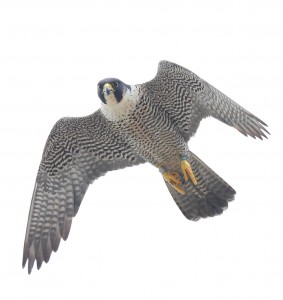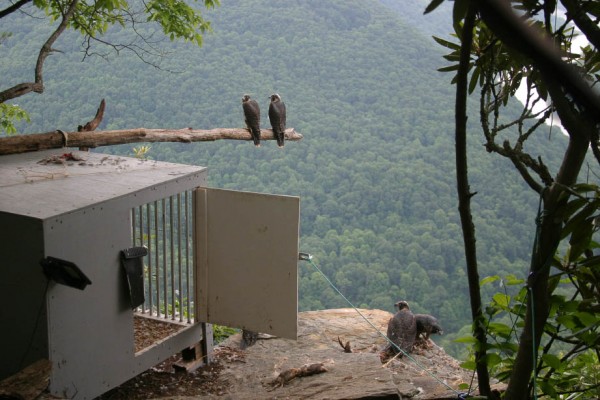Peregrine falcons thriving
Azalea in Virginia Beach July 5-8
July 8, 2010Camellia & Yellow-Crowned Night Heron
July 10, 2010
Written by Elizabeth Mojica
July 9, 2010

Adult female falcon breeding on Watts Island, VA. Photo by Bart Paxton.
Virginia’s population of peregrine falcons continued to thrive during the 2010 breeding season. This year 23 breeding pairs were documented, an increase of 2 pairs from last year. These breeding pairs produced 57 young that survived to banding age. The Center for Conservation Biology (CCB) has been actively involved with monitoring and managing peregrine falcons in Virginia since the species was reintroduced to the state in the late 1970s. Today’s population is a direct result of years of intensive management by CCB and its conservation partners.
Reproductive rates were higher in 2010 with 2.5 chicks/occupied territory and 2.9 chicks/active territory. The hatching rates were the highest on record with 93.5% hatching success.

Two falcon chicks, 1-2 days old, and an unhatched egg in the nest in Elkins Marsh, VA. Photo by Bart Paxton.

Three nestlings photographed during banding activities at a nest near Upshur Bay, VA. Photo by Libby Mojica.

Virginia’s Peregrine Falcon Population 1977-2010. Graph by the Center for Conservation Biology.

This adult male Peregrine Falcon established a new breeding territory on the Route 360 bridge in Tappahannock, VA. Photo by Bart Paxton.
Hacking programs continued this year in an ongoing effort to reintroduce the species into the southern Appalachian Mountains. CCB translocated 18 young falcons from coastal nests on bridges where fledging success is historically low, to hacking sites in the mountains of Virginia and West Virginia. The National Park Service (NPS) sponsored hacking sites at both Shenandoah and New River Gorge National Parks. The New River Gorge hack program was co-funded by WV Department of Natural Resources and the NPS and managed by Three Rivers Avian Center.

This hack site near Grandview in the New River Gorge National Park, WV is managed by Three Rivers Avian Center. Released falcons are provided with quail for several weeks until they can hunt their own prey. Photo by Three Rivers Avian Center.
Project sponsored by the Center for Conservation Biology (CCB), West Virginia Department of Natural Resources (WV DNR), Virginia Department of Game & Inland Fisheries (VDGIF), the National Park Service (NPS), and managed by Three Rivers Avian Center (TRAC).



